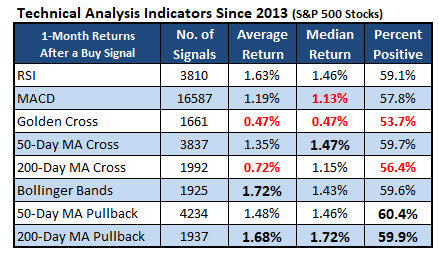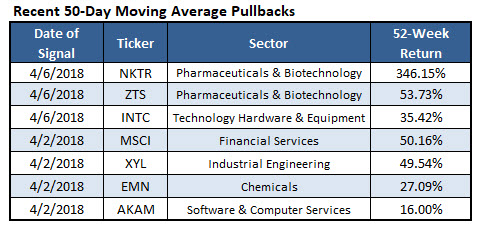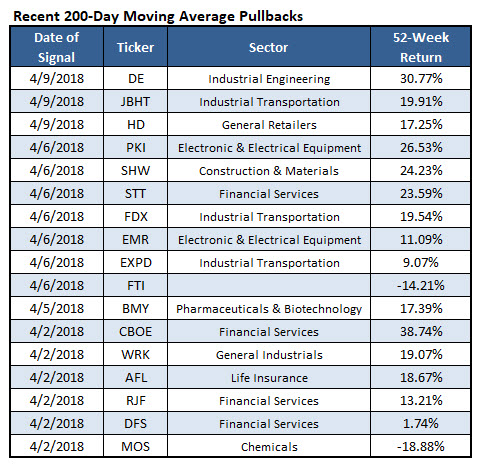2 of the Hottest Stock Buy Signals
 The golden cross doesn't shine as bright as some quants may expect
The golden cross doesn't shine as bright as some quants may expect
Any basic stock charting software comes with some standard technical analysis indicators including the RSI, MACD, moving averages, etc. I rarely see anyone try to measure their results, though. Which one works best? This week I'm going to try to answer that question. I've done this study in the past, but environments change, and indicators fall in and out of favor. Hopefully we'll get some insight on which technical analysis tool has been the most consistent over the long term and which one is hot (or not) right now.
Favorite Stock Market Indicators
Below are some of the indicators that I looked at. Different traders use these indicators differently and/or in combination with other indicators. Perhaps that is why no one else tries to quantify their performance. I am taking a very basic approach to what I call a "buy signal."
RSI:The RSI (Relative Strength Indicator) is an oscillator that ranges from zero to 100.A low-number reading suggests a stock is oversold and ready to bounce.A typical buy level for this indicator is 30.Because stocks can stay oversold for an extended period of time, the buy signal is defined as when the RSI goes from below 30 to above 30.In other words, it was oversold and now heading upward.MACD: The MACD (Moving Average Convergence/Divergence) is calculated using the difference in two moving averages for a stock. A moving average of that difference is then used and called the signal line. A common buy signal is generated when the MACD crosses above that signal line. Golden Cross: A golden cross is when a shorter-term moving average crosses above a longer-term moving average. In the analysis below, I used a 50-day and 200-day moving average. Moving Average Crossover: This is simply looking at the stock price crossing above a certain moving average.I compared returns after the price crossed above the 50- and 200-day moving averages. Bollinger Bands: These use a moving average, and then bands are placed two standard deviations above and below the moving average. When the stock price touches the lower band, it is often considered oversold and a bounce in the stock price is expected. Moving Average Pullbacks:For a stock on the rise, some traders might wait for a pullback to enter the position. One popular way to define a pullback -- which is then a buy signal -- is when the stock falls to within a range of a rising moving average. I consider pullbacks to the 50-day and 200-day moving average.Which Stock Signal Preceded the Best Returns?
For the study below, I looked at S&P 500 stocks and went back five years. I found the number of times a stock "signaled" for each indicator. The first table below shows the average and median stock returns over the next month of trading after a signal and also the percentage of time the return was positive.
I bolded the best two data points in each column and colored the worst two red. A quick glance shows stocks pulling back to their 200-day moving average performed well over the next month. That indicator showed an average return of 1.68% going forward, which was slightly below the return after a stock hit the lower Bollinger Band. Meanwhile, the percent positive after a pullback to the 50-day moving average was the best of all the indicators.
The golden cross indicator was the worst performing indicator by average return, median, and percent positive. The stock crossing its 200-day moving average was also an indicator that underperformed compared to the others.

This next table is like the one above except it only considers the signals from the past 12 months. The indicators can perform differently in different trading environments, so this tells us what has and has not worked more recently. Pullbacks to those two moving averages -- the 50 day and 200 day -- have been the best indicators recently.
The Bollinger band indicator, which had the highest average return over the past five years, ranked only fifth out of eight indicators when looking at the more recent returns. Moving average crossovers and, again, the golden cross indicator have not done well over the past 12 months.

Best Stocks After 50-Day, 200-Day Pullbacks
Here's a list of stocks that have recently signaled a pullback to their 50-day or 200-day moving average. The tables are sorted by date and then how well they've done over the past 52 weeks. This might be a good list to begin with if you're looking for short-term trades. (Note that it includes signals through Monday, so it does not show stocks that signaled yesterday).

